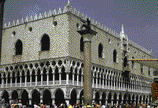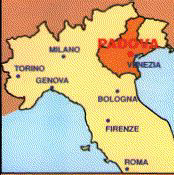 |
 |
 |
 |


At the beginning of the seventeenth century, Venice was the capital of the independent Venetian Republic. It was ruled by the Doge and a council with ten members (dieci), who helped to manage the state's affairs. The Doge was elected by the council of state, which was made up of representatives of rich and noble families.

In practice, the republic was administered by professional officials, who had to be citizens of Venice and who were appointed to their posts after a series of difficult examinations. Venice was the republic's center of industry, trade, and culture. More than 140,000 people lived there (a very large population for those days). Padua, another city in the republic, possessed an ancient university, where Galileo taught during the time in which he lived in the Venetian Republic (1592-1610).

During the sixteenth century, the manufacture of silk and woolen textiles developed rapidly in the Republic. Silk production, for instance, grew sixfold until it was almost as large an industry as it was in Florence. Venice exported silk and wool textiles, dyed by a special method, throughout Europe. Venetian glass was particularly famous. A special high quality type of glass and a unique range of colors were developed at the glassworks of Murano, near Venice. Chemical industries were also developed, producing sugar and soap, and the city was famous both for its metalwork and as a center of printing; Hebrew books were printed here and distributed throughout Europe.
As a commercial center, Venice controlled trade on the Mediterranean Sea, and imported many products from Asia to Europe. Until the sixteenth century it owned a large merchant fleet and important shipyards. However, it later lost control of the Mediterranean Sea, including key ports such as those on Crete and Cyprus, to the Ottoman Turks.
In the seventeenth century, Venetian exports suffered from competition with other exporters. In Constantinople, where Venice had been the sole importer, England succeeded in increasing the share of its products to 40% of the market. As a result of their loss of control of the Mediterranean Sea, Venetian shipbuilding was affected; fewer ships were built at Venice and several shipyards were closed.
Culture After the discovery of a sea route to India and the Ottomans' rise to power in the Mediterranean Sea, Venice gradually began to lose its position as an international center of trade. It was still an important economic and cultural center in Europe, however, where people from different countries met and exchanged ideas and opinions. At the beginning of the sixteenth century, the Venetian government removed the ban on theatrical performances. Groups of street players began to perform in the houses of the nobles who were their patrons, and later began to charge admission. The theater became a profitable concern, and investors built halls for different groups. This encouraged not only the development of drama in Venice but also the development of the architecture of public buildings there and elsewhere, such as the Barberini Theater, a private theater in Rome, and the Pergola Theater, a commercial theater in Florence.
 Italy
Italy
 The Duchy of Tuscany
The Duchy of Tuscany
 The Papal States
The Papal States

| Andrea / | Mail / | Home Page |
|---|
 |
 |
 |
|---|
![]() KNOWMAGINE - http://muse.tau.ac.il/~museum
KNOWMAGINE - http://muse.tau.ac.il/~museum